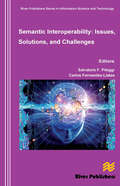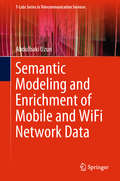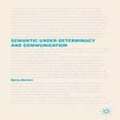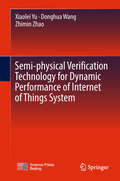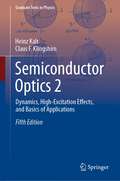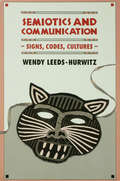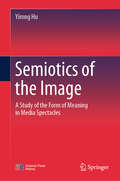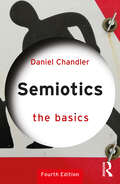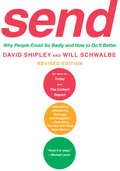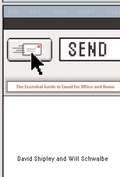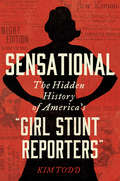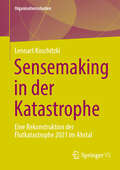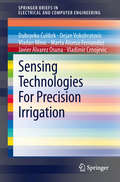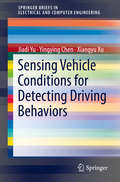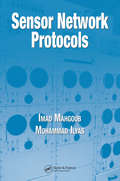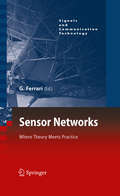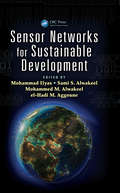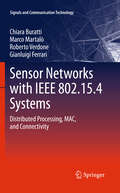- Table View
- List View
Semantic Interoperability Issues, Solutions, Challenges (River Publishers Series In Information Science And Technology Ser.)
by Carlos Fernandez-Llatas Salvatore F. PileggiSemantic technologies are experimenting an increasing popularity in the context of different domains and applications. The understanding of any class of system can be significantly changed under the assumption any system is part of a global ecosystem known as Semantic Web.The Semantic Web would be an evolving extension of current Web model (normally referred as Syntactic Web) that introduces a semantic layer in which semantics, or meaning of information, are formally defined.So, semantics should integrate web-centric standard information infrastructures improving several aspects of interaction among heterogeneous systems. This is because common interoperability models are progressively becoming obsolete if compared with the intrinsic complexity and always more distributed focus that feature modern systems. For example, the basic interoperability model, that assumes the interchange of messages among systems without any interpretation, is simple but effective only in the context of close environments. Also more advanced models, such as the functional interoperability model that integrates basic interoperability model with the ability of intepretating data context under the assumption of a shared schema for data fields accessing, appears not able to provide a full sustainable technologic support for open systems.The Semantic Interoperability model would improve common interoperability models introducing the interpretation of means of data. Semantic interoperability is a concretely applicable interaction model under the assumption of adopting rich data models (commonly called Ontology) composed of concepts within a domain and the relationships among those concepts.In practice, semantic technologies are partially inverting the common view at actor intelligence: intelligence is not implemented (only) by actors but it is implicitly resident in the knowledge model. In other words, schemas contain information and the "code" to interpretate it.
Semantic Modeling and Enrichment of Mobile and WiFi Network Data (T-Labs Series in Telecommunication Services)
by Abdulbaki UzunThis book discusses the fusion of mobile and WiFi network data with semantic technologies and diverse context sources for offering semantically enriched context-aware services in the telecommunications domain.It presents the OpenMobileNetwork as a platform for providing estimated and semantically enriched mobile and WiFi network topology data using the principles of Linked Data. This platform is based on the OpenMobileNetwork Ontology consisting of a set of network context ontology facets that describe mobile network cells as well as WiFi access points from a topological perspective and geographically relate their coverage areas to other context sources.The book also introduces Linked Crowdsourced Data and its corresponding Context Data Cloud Ontology, which is a crowdsourced dataset combining static location data with dynamic context information. Linked Crowdsourced Data supports the OpenMobileNetwork by providing the necessary context data richness for more sophisticated semantically enriched context-aware services.Various application scenarios and proof of concept services as well as two separate evaluations are part of the book. As the usability of the provided services closely depends on the quality of the approximated network topologies, it compares the estimated positions for mobile network cells within the OpenMobileNetwork to a small set of real-world cell positions. The results prove that context-aware services based on the OpenMobileNetwork rely on a solid and accurate network topology dataset. The book also evaluates the performance of the exemplary Semantic Tracking as well as Semantic Geocoding services, verifying the applicability and added value of semantically enriched mobile and WiFi network data.
Semantic Under-Determinacy and Communication
by Delia BelleriCombining a fresh, previously unexplored view of the subject with a detailed overview of the past and ongoing philosophical discussion on the matter, this book investigates the phenomenon of semantic under-determinacy by seeking an answer to the questions of how it can be explained, and how communication is possible despite it.
Semantics and Communication
by John C. Condon Jr.New to the third edition is an exploration of creativity and problem solving in terms of semantics.
Semantische Frames in interkultureller Markenkommunikation (Europäische Kulturen in der Wirtschaftskommunikation #38)
by Lisa HackingerUnter Anwendung der Frame-Theorie wird in diesem Buch die Rolle von nicht-verbalisiertem Vorwissen in der interkulturellen Markenkommunikation untersucht. Eine starke Marke ist ein sowohl komplexes als auch fiktionales Konstrukt, das sich neben verschiedenen Oberflächenmerkmalen auch aus Assoziationen, Empfindungen und Hintergrundwissen zur Marke zusammensetzt. Mit einer kognitiv-linguistischen Vorgehensweise wird anhand von vier Fallbeispielen analysiert, welche unterschiedlichen Kommunikationsstrategien etablierte Unternehmen zur interkulturellen Positionierung von Marken nutzen und inwieweit diese sich in der Wahrnehmung der Rezipienten widerspiegeln. Dabei wird von einem holistischen Denkansatz ausgegangen, bei dem Sprachwissen und Weltwissen eine untrennbare Einheit darstellen und der Fokus liegt darauf, zu verstehen, wie abstraktes und künstlich erzeugtes Wissen um eine Marke kommunikativ etabliert werden kann und welche Rolle die landeskulturelle Bedingtheit hierbei spielt.
Semi-physical Verification Technology for Dynamic Performance of Internet of Things System
by Xiaolei Yu Donghua Wang Zhimin ZhaoThis book combines semi-physical simulation technology with an Internet of Things (IOT) application system based on novel mathematical methods such as the Fisher matrix, artificial neural networks, thermodynamic analysis, support vector machines, and image processing algorithms. The dynamic testing and semi-physical verification of the theory and application were conducted for typical IOT systems such as RFID systems, Internet of Vehicles systems, and two-dimensional barcode recognition systems. The findings presented are of great scientific significance and have wide application potential for solving bottlenecks in the development of RFID technology and IOT engineering. The book is a valuable resource for postgraduate students in fields such as computer science and technology, control science and engineering, and information science. Moreover, it is a useful reference resource for researchers in IOT and RFID-related industries, logistics practitioners, and system integrators.
Semiconductor Optics 2: Dynamics, High-Excitation Effects, and Basics of Applications (Graduate Texts in Physics)
by Heinz Kalt Claus F. KlingshirnThis book provides an introduction to and an overview of the multifaceted area of dynamics and nonlinearities related to optical excitations in semiconductors. It is a revised and significantly extended edition of the well-established book by C. Klingshirn split into two volumes and restructured to make it more concise. Inserts on important experimental techniques, reference to topical research and novel materials, as well as consideration of photonic applications support research-oriented teaching and learning. This book reviews nonlinear optical properties and many-body phenomena evoked by high densities of quasi-particles in semiconductors. Coherent dynamics and relaxation of optical excitations (carriers, excitons, electron–hole plasmas, etc.) as well as condensation phenomena are elucidated in these materials. A broad overview is provided of seminal research results augmented by detailed descriptions of the relevant experimental techniques, e.g., ultrafastspectroscopy, four-wave mixing, and the Hanbury-Brown and Twiss experiment. Offering a comprehensive introduction to hot topics in current research — polariton condensates, valley coherence, and single photons, to name a few, it also discusses applications of the described physical concepts in topical areas, such as quantum information, photonics, spintronics, and optoelectronics.Covering subjects ranging from physics to materials science and optoelectronics, the book provides a lively and comprehensive introduction to semiconductor optics beyond the linear regime.With many problems, chapter introductions, schematic depictions of physical phenomena, as well as boxed inserts and a detailed index, it is suitable for use in graduate courses in physics and neighboring sciences like material science and optical communication. It is also a valuable reference resource for doctoral and advanced researchers.
Semiotics and Communication: Signs, Codes, Cultures (Routledge Communication Ser.)
by Wendy Leeds-HurwitzCommunication is, among other things, about the study of meaning -- how people convey ideas for themselves and to one another in their daily lives. Designed to close the gap between what we are able to do as social actors and what we are able to describe as social analysts, this book introduces the language of semiotics -- a language that provides
Semiotics of the Image: A Study of the Form of Meaning in Media Spectacles
by Yirong HuThis book provides a groundbreaking exploration of image semiotics. Going far beyond traditional analyses of static visual texts, it includes dynamic imagery, literary iconography, and psychological images, offering a holistic view of how semiotics permeates various forms of media and cultural expression. The book integrates various case studies on Chinese culture, providing scholars outside China a unique lens through which to understand Chinese cultural thinking through semiotics. This approach not only enriches the academic discussion but also enhances cross-cultural understanding. In addition, the book collects and synthesizes significant achievements in semiotics, incorporating traditional visual theory research from the Panofsky and Warburg schools. This synthesis forms a comprehensive “semiotics of images,” providing an interdisciplinary analytical framework for contemporary “media spectacles.” The book employs multiple methodologies to dissect the visual image spectacles constructed by modern media signs, culminating in a macro-level understanding of cultural spectacles. Furthermore, it situates the comparison between Chinese and Western civilizations within a broad context of cultural philosophy and history, enriching the discourse on cultural differences and similarities.
Semiotics: The Basics (The Basics)
by Daniel ChandlerThis fourth edition of the bestselling textbook, now available in print, eBook, and audiobook, has been fully updated, continuing to provide a concise introduction to the key concepts of semiotics in accessible and jargon-free language. Demystifying what is a complex, highly interdisciplinary field, key questions covered include: what are signs and codes? What can semiotics teach us about representation and reality? What tools does it offer for analysing texts and cultural practices? The fourth edition of Semiotics: The Basics focuses in particular on its application to communication and cultural studies. It has been extensively revised and extended, with an entirely new section on cognitive semiotics, many more illustrations, and a new glossary. With updates to theory, further examples, and suggestions for review and further reading, this must-have resource is both the ideal introductory text and an essential reference guide for students at all levels of language and communication, media, and cultural studies.
Semántica: Una introducción al significado lingüístico en español
by Carmen CurcóSemántica: Una introducción al significado lingüístico en español es una introducción integral al estudio de la semántica con un enfoque especial en la lengua española. Sin asumir conocimientos lingüísticos previos, el libro conduce al lector por los principales temas del estudio del significado, logrando un equilibrio entre la teoría y la práctica. Los temas nocionales y las discusiones conceptuales se entrelazan con el desarrollo de herramientas analíticas. Las explicaciones se apoyan en abundantes ejemplos que ilustran los puntos tratados. Cada capítulo proporciona ejercicios y sugerencias para lecturas e investigaciones adicionales con el fin de guiar a los estudiantes de español en las complejidades de la semántica léxica y composicional. Escrito íntegramente en español en un estilo claro y atractivo, el libro es ideal para estudiantes avanzados de pregrado y posgrado de español y lingüística hispánica. Semántica: Una introducción al significado lingüístico en español is a comprehensive introduction to the study of semantics with a special focus on Spanish. Without assuming prior linguistic knowledge, the book leads the reader through the main topics in the study of meaning, striking a balance between theory and practice. In a clear and engaging style, notional issues and conceptual discussions are intertwined with the development of analytical tools. Explanations are supported by plentiful examples to reinforce each new point. Exercises and suggestions for further reading and research are provided throughout to guide students of Spanish seamlessly into the complexities of lexical and compositional semantics. Written entirely in Spanish, the book is ideal for advanced undergraduate and graduate students of Spanish and Spanish linguistics.
Send
by David Shipley Will SchwalbeThe Essential Guide to Email for Office and Home bull; When should you email, and when should you call, fax, or just show up? bull; What is the crucial-and most often overlooked-line in an email? bull; What is the best strategy when you send (in anger or error) a potentially career-ending electronic bombshell? Enter Send. Whether you email just a little or never stop, here, at last, is an authoritative book that shows how to write the perfect email anywhere. Send also points out the numerous (but not always obvious) times when email can be the worst option and might land you in hot water (or even jail!). The secret is, of course, to think before you click. Send is nothing short of a survival guide for the digital age-wise, brimming with good humour, and filled with helpful lessons from the authors' own email experiences (and mistakes). In short: absolutely e-essential.
Send: The Essential Guide to Email for Office and Home
by David Shipley Will SchwalbeThe hows and whys of using email, and how to communicate effectively.
Seneca Selected Letters (Oxford World's Classics)
by Elaine Fantham Seneca Corporation StaffWe often speak of Seneca as the most distinguished of the many Spanish writers and poets of Rome's imperial age, starting from his own father of the same name, and his nephew Lucan, and including Columella, Martial, and Quintilian. But although all of these writers came from Spain, they were Roman (or Italian) in descent, culture, and tradition. Scipio Africanus had taken eastern and southern Spain from the Carthaginians during the Hannibalic war, and most of the Spanish peninsula had been Roman since the second century BCE.
Sensational: The Hidden History of America's "Girl Stunt Reporters"
by Kim Todd"A gripping, flawlessly researched, and overdue portrait of America’s trailblazing female journalists. Kim Todd has restored these long-forgotten mavericks to their rightful place in American history."—Abbott Kahler, author (as Karen Abbott) of The Ghosts of Eden Park and Liar, Temptress, Soldier, Spy A vivid social history that brings to light the “girl stunt reporters” of the Gilded Age who went undercover to expose corruption and abuse in America, and redefined what it meant to be a woman and a journalist—pioneers whose influence continues to be felt today.In the waning years of the nineteenth century, women journalists across the United States risked reputation and their own safety to expose the hazardous conditions under which many Americans lived and worked. In various disguises, they stole into sewing factories to report on child labor, fainted in the streets to test public hospital treatment, posed as lobbyists to reveal corrupt politicians. Inventive writers whose in-depth narratives made headlines for weeks at a stretch, these “girl stunt reporters” changed laws, helped launch a labor movement, championed women’s rights, and redefined journalism for the modern age.The 1880s and 1890s witnessed a revolution in journalism as publisher titans like Hearst and Pulitzer used weapons of innovation and scandal to battle it out for market share. As they sought new ways to draw readers in, they found their answer in young women flooding into cities to seek their fortunes. When Nellie Bly went undercover into Blackwell’s Insane Asylum for Women and emerged with a scathing indictment of what she found there, the resulting sensation created opportunity for a whole new wave of writers. In a time of few jobs and few rights for women, here was a path to lives of excitement and meaning.After only a decade of headlines and fame, though, these trailblazers faced a vicious public backlash. Accused of practicing “yellow journalism,” their popularity waned until “stunt reporter” became a badge of shame. But their influence on the field of journalism would arc across a century, from the Progressive Era “muckraking” of the 1900s to the personal “New Journalism” of the 1960s and ’70s, to the “immersion journalism” and “creative nonfiction” of today. Bold and unconventional, these writers changed how people would tell stories forever.
Sense and Nonsense: A Study in Human Communication
by Alfred FleishmanA book on semantics and how to improve general communication.
Sensemaking in der Katastrophe: Eine Rekonstruktion der Flutkatastrophe 2021 im Ahrtal (Organisationsstudien)
by Lennart KoschitzkiDieses Buch bietet eine soziologische Perspektive auf die Flutkatastrophe 2021 im Ahrtal – und zeigt damit Strukturen und Bedingungen auf, welche im Hintergrund der Flutnacht zu ihren tragischen Ausmaßen führten. Nach Desastern steht oft die Frage im Raum, wie es trotz nachweislich vorliegender Warnsignale zu einer derartigen Eskalation kommen konnte. Auch nach der Flut im Kreis Ahrweiler erscheinen die Fehlentscheidungen bei den Verantwortlichen nicht nachvollziehbar. In diesem Buch wird zur Beleuchtung dieser Rätsel ein anderer Blickwinkel vorgeschlagen: Das kritischste Element der Flutkatastrophe und deren missglückter Bewältigung lag nicht in Fehlentscheidungen, sondern in den zugrundeliegenden Fehleinschätzungen. Unter Zuhilfenahme von „Sensemaking“ nach Karl E. Weick werden diese Fehleinschätzungen vom 14. und 15. Juli 2021 in ihren Kontexten sicht- und greifbar gemacht. Neben dem fokussierten Krisenstab in Bad Neuenahr-Ahrweiler werden auch weitere zentrale Akteure und widrige Gegebenheiten dieses Zusammenhangs untersucht. Darüber hinaus werden organisationale Einflussfaktoren der Flutkatastrophe herausgestellt; denn wie bei allen Katastrophen bildete sie sich aus dem Zusammenspiel mehrerer, teils völlig voneinander unabhängiger Aspekte. Für das ergänzende Verständnis wird neben einer einführenden Rekonstruktion des Katastrophenhergangs auch eine Einordnung von Krisenstäben als organisationaler Sonderform im hier betrachteten Sinne geboten. Daraus ergibt sich die Gelegenheit, aus den Geschehnissen im Kreis Ahrweiler zu lernen. Damit bietet dieses Buch insbesondere für Katastrophenforscher und Katastrophenschützer Impulse und Lektionen.
Sensing Technologies For Precision Irrigation
by Dejan Vukobratovic Marta Alonso Fernandez Vladan Minic Dubravko Ćulibrk Vladimir Crnojevic Javier Alvarez OsunaThis brief provides an overview of state-of-the-art sensing technologies relevant to the problem of precision irrigation, an emerging field within the domain of precision agriculture. Applications of wireless sensor networks, satellite data and geographic information systems in the domain are covered. This brief presents the basic concepts of the technologies and emphasizes the practical aspects that enable the implementation of intelligent irrigation systems. The authors target a broad audience interested in this theme and organize the content in five chapters, each concerned with a specific technology needed to address the problem of optimal crop irrigation. Professionals and researchers will find the text a thorough survey with practical applications.
Sensing Vehicle Conditions for Detecting Driving Behaviors (Springerbriefs In Electrical And Computer Engineering)
by Yingying Chen Jiadi Yu Xiangyu XuThis SpringerBrief begins by introducing the concept of smartphone sensing and summarizing the main tasks of applying smartphone sensing in vehicles. Chapter 2 describes the vehicle dynamics sensing model that exploits the raw data of motion sensors (i.e., accelerometer and gyroscope) to give the dynamic of vehicles, including stopping, turning, changing lanes, driving on uneven road, etc. Chapter 3 detects the abnormal driving behaviors based on sensing vehicle dynamics. Specifically, this brief proposes a machine learning-based fine-grained abnormal driving behavior detection and identification system, D3, to perform real-time high-accurate abnormal driving behaviors monitoring using the built-in motion sensors in smartphones.As more vehicles taking part in the transportation system in recent years, driving or taking vehicles have become an inseparable part of our daily life. However, increasing vehicles on the roads bring more traffic issues including crashes and congestions, which make it necessary to sense vehicle dynamics and detect driving behaviors for drivers. For example, sensing lane information of vehicles in real time can be assisted with the navigators to avoid unnecessary detours, and acquiring instant vehicle speed is desirable to many important vehicular applications. Moreover, if the driving behaviors of drivers, like inattentive and drunk driver, can be detected and warned in time, a large part of traffic accidents can be prevented. However, for sensing vehicle dynamics and detecting driving behaviors, traditional approaches are grounded on the built-in infrastructure in vehicles such as infrared sensors and radars, or additional hardware like EEG devices and alcohol sensors, which involves high cost. The authors illustrate that smartphone sensing technology, which involves sensors embedded in smartphones (including the accelerometer, gyroscope, speaker, microphone, etc.), can be applied in sensing vehicle dynamics and driving behaviors. Chapter 4 exploits the feasibility to recognize abnormal driving events of drivers at early stage. Specifically, the authors develop an Early Recognition system, ER, which recognize inattentive driving events at an early stage and alert drivers timely leveraging built-in audio devices on smartphones. An overview of the state-of-the-art research is presented in chapter 5. Finally, the conclusions and future directions are provided in Chapter 6.
Sensitive Reading: The Pleasures of South Asian Literature in Translation
by Yigal Bronner and Charles HalliseyA free open access ebook is available upon publication. Learn more at www.luminosoa.org. What are the pleasures of reading translations of South Asian literature and what does it take to enjoy them? This volume explores these questions by bringing together a whole set of new translations by David Shulman, noted scholar of South Asia. The translated selections come from a variety of Indian languages, genres, and periods, from classical to current. They are accompanied by short essays especially written to help readers engage and enjoy them. Some of these essays provide background to enhance any reading of the translation while others model how to expand appreciation in broader and comparative ways. Taken together, the translations and the accompanying essays form an essential guide for people interested in literature and art from South Asia.
Sensor Network Protocols
by Mohammad Ilyas Imad MahgoubSensor networks continue to grow in importance for modern communication networks. Communication protocols are at the core of these networks, determining their ability to function, their capabilities, and the environments in which they are able to operate. In chapters carefully selected from the popular Handbook of Sensor Networks, Sensor Network Protocols supplies a sharply focused reference on protocols, security, data processing, and energy management in communication sensor networks that is ideal for specialists in the field. Providing a succinct guide to the protocols currently used in advanced sensor networks, this book focuses on four main areas: routing protocols; data gathering and processing; security and reliability; and energy management. The book opens with a survey of the challenges and opportunities facing the field. Then, expert contributors authoritatively discuss routing technologies, next-generation enabling technologies, comparative study of energy-efficient protocols for wireless sensor networks, techniques to reduce computation and communication energy consumption, energy-aware routing, localized algorithms for sensor networks, and much more.Sensor Network Protocols details the techniques and technologies that are at the heart of modern sensor networks. It is an ideal reference for anyone interested in designing, planning, or building emerging sensor and communications networks.
Sensor Networks
by Gianluigi FerrariThis book collects very recent results in the realm of sensor networking. In particular, it links the theory of sensor networking with practical and implementation aspects. Such, it highlights how sensor networking represents a very interesting research/application area, allowing a researcher to apply his theories and a practitioner to "see" the theories behind his/her used technologies.
Sensor Networks and Signal Processing: Proceedings of the 2nd Sensor Networks and Signal Processing (SNSP 2019), 19-22 November 2019, Hualien, Taiwan (Smart Innovation, Systems and Technologies #176)
by Margarita N. Favorskaya Han-Chieh Chao Sheng-Lung PengThis book offers a collection of high-quality research papers presented at the 2nd International Conference on Sensor Networks and Signal Processing (SNSP 2019), held in Taiwan on November 19–22, 2019. It presents novel contributions in the areas of sensor and actuator networks, wireless networks, networking and protocols, security and privacy, wireless communications, distributed algorithms, Internet of Things, system modeling and performance analysis, fault tolerance/diagnostics, information management, data mining and analysis, embedded systems design, signal theory, signal and image processing, detection and estimation, spectral analysis, software developments, pattern recognition, data processing, remote sensing, big data, machine learning, information and coding theory, and industrial applications.
Sensor Networks for Sustainable Development
by Mohammad Ilyas el-Hadi M. Aggoune Sami Alwakeel Mohammed AlwakeelRecent advances in technology and manufacturing have made it possible to create small, powerful, energy-efficient, cost-effective sensor nodes for specialized telecommunication applications—nodes "smart" enough to be capable of adaptation, self-awareness, and self-organization. Sensor Networks for Sustainable Development examines sensor network technologies that increase the quality of human life and encourage societal progress with minimal effect on the earth’s natural resources and environment. Organized as a collection of articles authored by leading experts in the field, this valuable reference captures the current state of the art and explores applications where sensor networks are used for sustainable development in: Agriculture Environment Energy Healthcare Transportation Disaster management Beneficial to designers and planners of emerging telecommunication networks, researchers in related industries, and students and academia seeking to learn about the impact of sensor networks on sustainable development, Sensor Networks for Sustainable Development provides scientific tutorials and technical information about smart sensor networks and their use in everything from remote patient monitoring to improving safety on the roadways and beyond.
Sensor Networks with IEEE 802.15.4 Systems
by Roberto Verdone Gianluigi Ferrari Marco Martalo' Chiara BurattiThis book presents a simple, yet complete, approach to the design and performance analysis of distributed processing algorithms and techniques suitable for IEEE 802.15.4 networks. In particular, the book focuses on the bottom two layers of the ISO/OSI stack (Physical and Medium Access Control), discussing also a few issue related to routing. The book is a the synergistic combination of signal processing aspects on the one hand and MAC and connectivity issues on the other hand. The goal of the book is to clearly link physical layer aspects with medium access and topology aspects, in order to provide the reader with a clear understanding of how to approach the design of proper distributed signal processing and medium access algorithms in this context.
